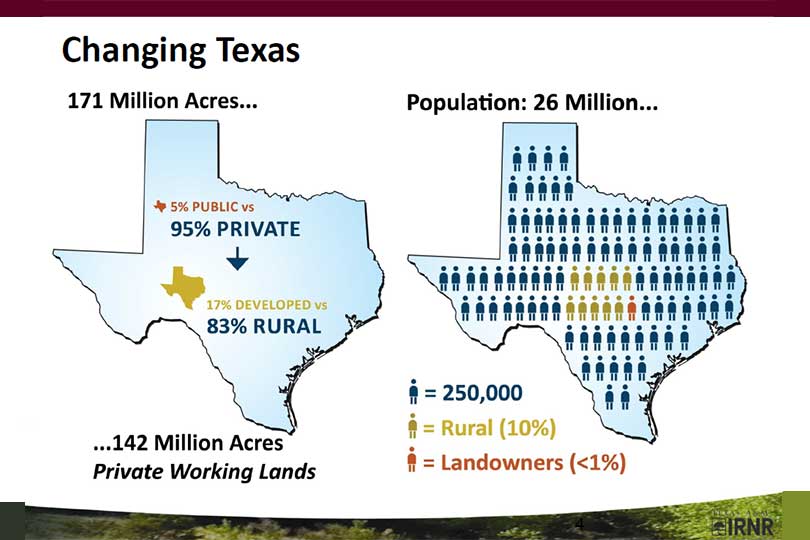By Gary Joiner
TFB Radio Network Manager
Is Texas a rural state?
Yes. Eighty-three percent of the state’s lands are farms, ranches and forests.
But it’s also an urban state. Eighty-six percent of Texans live in urban areas.
Such are the dynamics of the Lone Star State, according to Dr. Roel Lopez, director of the Texas A&M Natural Resources Institute.
Lopez oversees Texas Land Trends, a project that tracks the trends of farms and ranches in the state. It was developed by Texas A&M Natural Resources Institute in cooperation with Texas A&M AgriLife Research, Texas A&M AgriLife Extension Service and Texas Agricultural Land Trust.
“The state is comprised of 142 million acres of farms, ranches and family forests. And the value of those lands to the 26 million Texans ranges from clean water, recreational opportunities, to open space. So, collectively, efforts to conserve those lands and promote the stewardship of those lands via private landowners are something that is important to all of us, whether you live in a city or in a rural community,” said Lopez in an interview with the Texas Farm Bureau Radio Network.
It’s reported that the U.S. loses 50 acres of farmland every hour. Two million acres a year are lost to development across the country.
In Texas, fragmentation occurs alongside population growth. Texas A&M Natural Resources Institute reports more than 54 percent of total land conversion from 1997-2012 occurred in the state’s 25 fastest-growing counties. During this period, about 590,000 acres were lost from the agricultural land base in these counties.
“Fragmentation is the breakup of a farm or ranch into smaller pieces,” Lopez said. “Typically, what we see when that happens is there’s an increased likelihood of conversion moving into some other non-ag use. Fragmentation concerns us all.”
When newcomers move to Texas, most arrive in specific areas of the state.
“About 65 percent of the new growth occurs in 10 counties—counties that encompass Dallas-Fort Worth, Houston, Austin, San Antonio, the Rio Grande Valley and El Paso. So those are the primary regions of growth,” Lopez said.
He added about 40 percent of Texas landowners live in an urban center.
Eighty-five percent of land in Texas is managed by those who farm and ranch. That means 142 million acres of private working lands are owned by less than one percent of Texans. Lopez said the next 25 years represents the largest exchange of farm and ranch lands in the state’s history.
The 2017 U.S. Census of Agriculture will be a critical data set for the Texas Land Trends project. Lopez said Texas A&M Natural Resources Institute draws on two data sets—the U.S. Census of Agriculture, which is collected every five years, and state comptroller data, which is collected annually.
“Through the marriage of those two data sets, we can understand changes in land use, land values, land ownership, and so it’s almost like a land demography study, if you will, in understanding what’s happening to our farms, ranches and family forests,” he said.
Texas A&M Natural Resources Institute reports average ownership size in Texas declined from 581 acres in 1997 to 521 acres in 2012. By the end of 2012, the Census of Agriculture accounted for nearly 249,000 farming and ranching operations in the state, representing a nine percent increase since the 1997 census.


Fascinating facts about rural/urban Texas. With only 1% owning most of private lands, will the 99% realize the importance of rural lands to Texas?